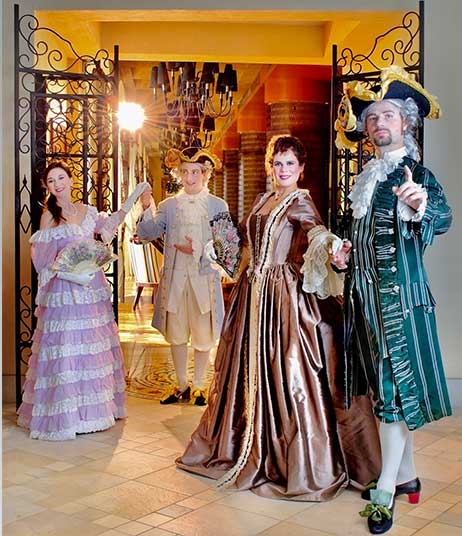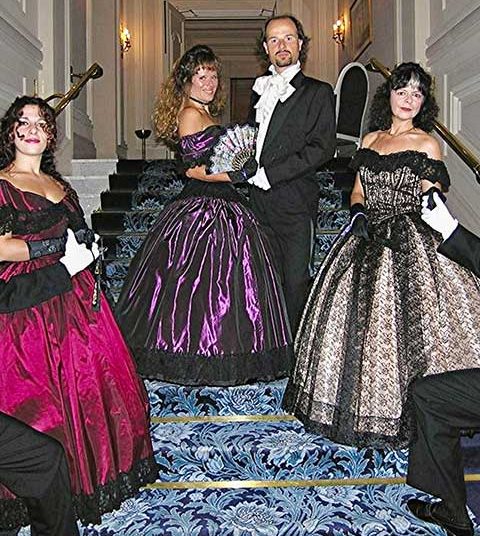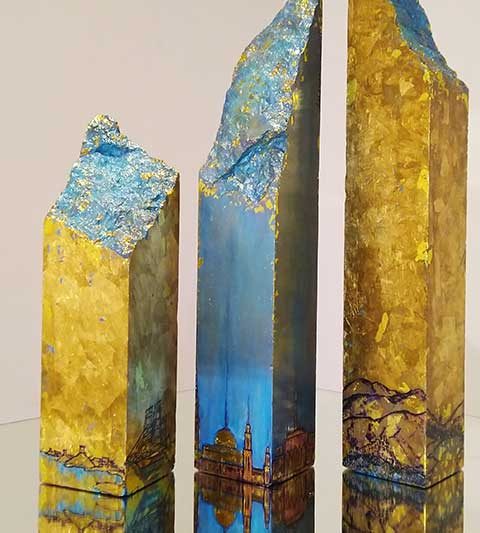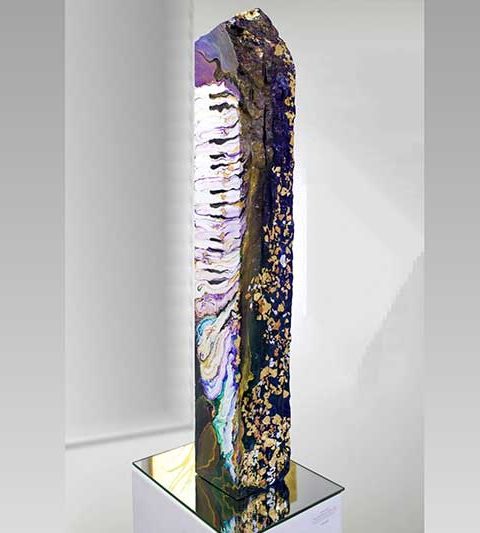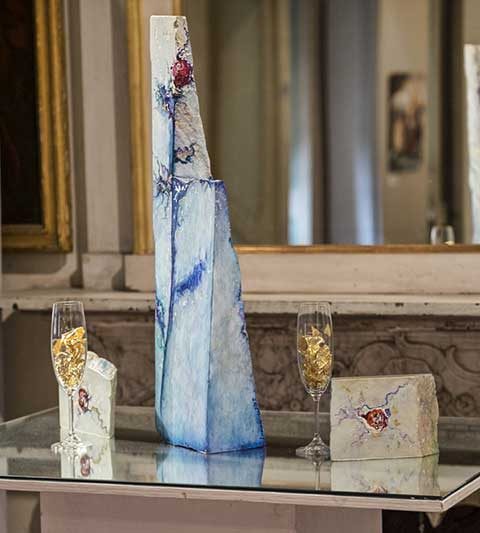The work of Lucia Oliva, eclectic contemporary artist, communicates through an intuitive and universal language, rich in astonishing scenic effects, meant to have both an emotional and a conceptual impact on the observer.
She is a self-taught artist, who grew up loving music, dance, sculpting, painting, literature and drama. Also, she likes to write poems. After an early award-winning debut as a young painter, she graduated in law and taught for a few years at Genoa University, then deciding to devote herself entirely to the artistic world and setting up with her husband an event company that brought them to organise shows all around the world. A decade ago she went back to figurative arts, as a development of her long international career in the world of art as choreographer, dancer and event organiser.
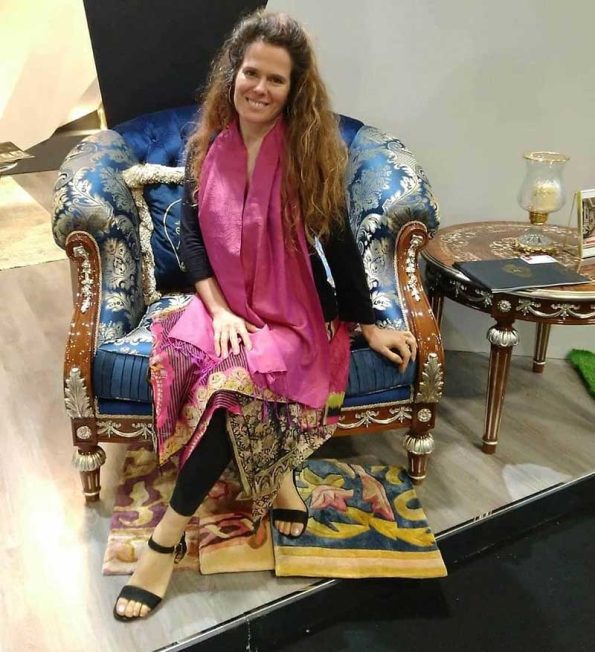
«Sculpting with colour» on stone, metal or other materials, Lucia creates subjects embodied in artworks rich in harmony and movement that highlight an idea of pure lightness.
Playing with mirrors and other accessories she recently invented her unique concept which creates a sort of contemporary “trompe l’oeil” effect, with original scenic set-ups that are a combination of sculpture, painting, installation and theatre: her peculiar interpretation of the anamorphosis phenomenon gives life to artworks that consist in a tangible side and an ethereal one, body and soul of the same entity.
Her unique art has been granted an immediate and ever growing success in many solo, group exhibitions and art symposiums all around the world. Her works are owned by private collectors in Europe as well as in the UAE, Oman, Bahrain, Saudi Arabia, Jordan, Egypt, the Philippines and other countries.
Among the standing out collections in the Middle East: H.H. Sheikh Ammar bin Humaid Al Nuaimi (UAE), H.H. Sheikh Zayed bin Hamdan bin Zayed Al Nahyan (UAE), H.E. Khalid Abdullah Al Ghurair (UAE), H.E. Abdul Majied Seddiqi (UAE), H.E. Dr. Mohammad Bin Al Zubair (Oman), H.E. Dr. Rasheed Al Safi Khamis Al Huraibi (Oman), Dr. Amit Ashiwn Dharamsey (Oman), Pharmacy One (Jordan).
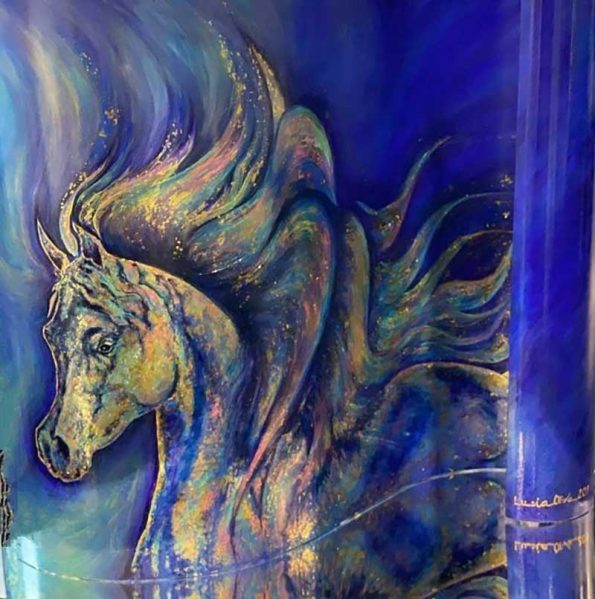
In the last months, I have interviewed some different artists and I realized that some of them have not studied about art, but are self-taught painters. Why?
I have always had interests in different fields, which I developed one next to the other aiming to fully express myself in each of them.
As far as fine arts are concerned, my education took place out of traditional academic paths, with constant and fruitful relationships with great masters, who helped me discover the value of creative inspiration as the main part of every artist, without which technique is merely «a servant without a master». Then I put the fascinating study of history of art side by side with technique, which is of course necessary.
I have always breathed art in my family in its broadest possible meaning. My mother loved theatre, opera and classical music. In my house the record player was often on and my mother used to sing on its notes: I was brought up in this atmosphere, among «The barber of Seville», «The Traviata», Mozart’s or Beethoven’s concerts… I got the passion for figurative arts from my father: he often spent time to tell us the life of famous artists, scientists, writers…
Since I was a child I also had a passion for artistic gymnastic and dance. Growing up, I discovered a new universe containing the main values of life I have always felt in my soul: the virtue of justice embodied in logic, which I found in the structure of Law, in its academic and purest aspect (later I understood with disappointment that in reality things are much different…).
When I had to choose my university course, all the other passions were overwhelmed by the one for law, which after that I kept cultivating with a seat as assistant professor of criminal law at Genoa University.
My self-taught art activity, thus, has always been a way to give voice to the polyhedric aspect of my personality.
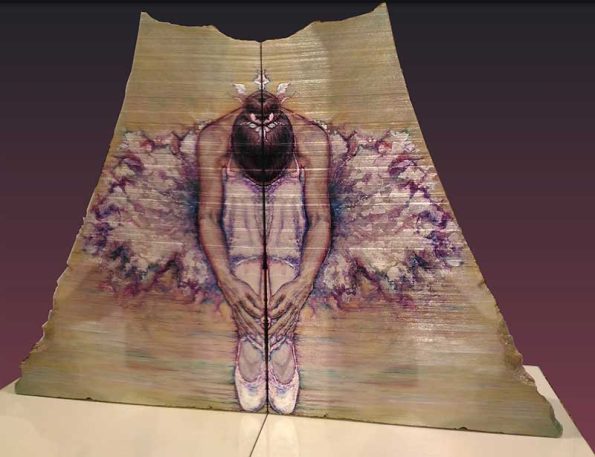 Your are considered an eclectic contemporary artist. How do you define this eclectic style?
Your are considered an eclectic contemporary artist. How do you define this eclectic style?
I could respond with one word: fusion.
To answer this question I need to say something more about my artistic path. From the passion for theatre and opera that I «inherited» from my mother, in 2000 I founded the art company Ludica Antiqua, which I created with my husband Luca, lawyer with the same artistic soul. The aim of our art ensemble is to let «people enjoy by playing with culture» through interactive shows that combine together legends or historical anecdotes, opera, dance performances, mime, magic… often involving the guests in literary games and big quadrilles. The company relies on artists of all kinds (classical musicians, opera singers, actors, acrobats, magicians…) and our career brought us to organise events in the most different areas of the world.
I often took personal care of the creation of backdrops, of the design of period costumes and scene objects. So, in a way, I never stopped creating figurative arts… even in theatre.
Through time I thought about the eclectic aspect of my art, trying to understand its roots. By putting together remarks and appreciations I got from critics and collectors I might sum up the whole answer by saying that my sculptural and 3D artworks, that blend painting, sculpture and often installations, have their roots in my love for dance, movement and body expression, together with the pathos of the scenic effect of surprise that is typical of theatre.
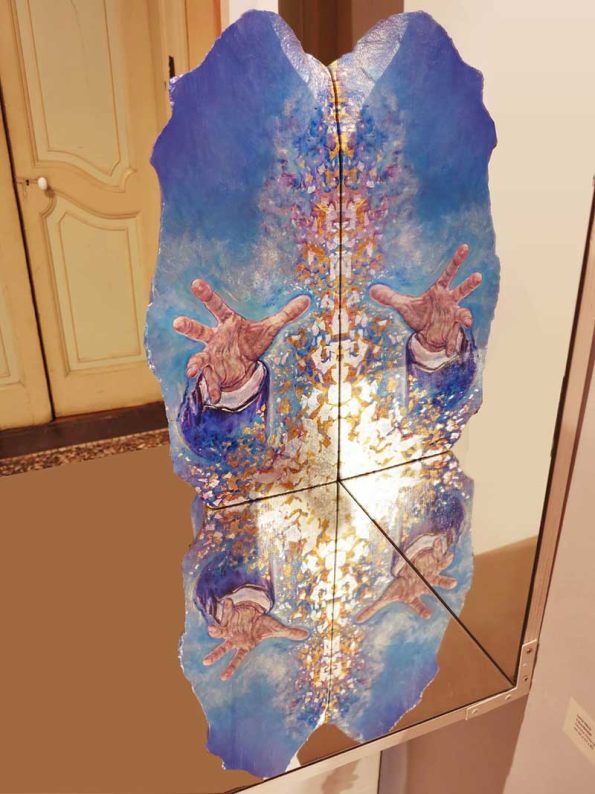
Your origins are in Italy, but you decide to live in Oman. Why and what Oman add to you as artist?
My life is currently divided between Italy and Oman.
In Italy we chose to live in a remote unique wildlife sanctuary and paradise Unesco heritage: Alicudi, a completely tiny pedestrian island off the coasts of Sicily, a place chosen by many international artists as their home to have special inspiration. Here time seems to have stopped and life has a different meaning, more focused on the essential values of life.
Here is a short video about the art studio on the island: https://www.youtube.com/watch?v=M_mnKW4Joh8&t=129s
In Oman we found our “paradise” in the traditional fishermen village of Qantab, 10 mns from the capital Muscat but very far away from the routine and confusion of the everyday’s life of a big city. Though Muscat is not New York or Paris and is relatively calm, Qantab reminds me of «our Alicudi» in Italy.
To answer what Oman adds to my life as an artist, I could again use the word “fusion”. My education, obviously mainly bound to the culture and history of western art, was enriched by getting in close contact with the Arab world and its different cultures, which allowed me to discover the beauty of Islamic art and new perspectives and visions: the silence, a different idea of time…
Getting in touch with this reality, the power of colour and the love for light (which have always characterised my style) turned enriched by the suggestions of gold and metal effects in many different ways.
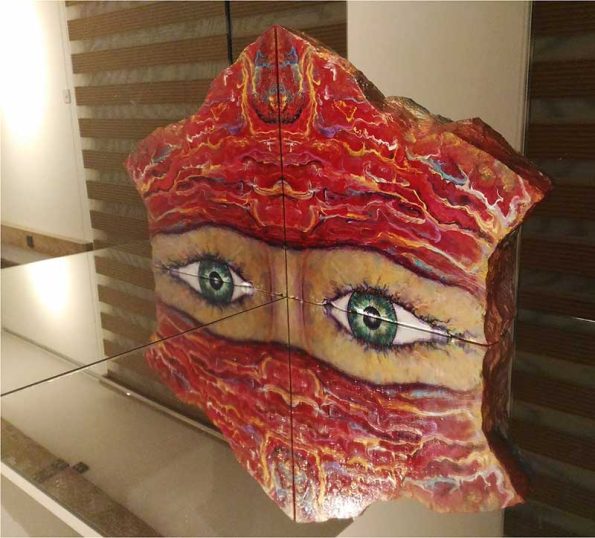
You recently invented your unique concept which creates a sort of contemporary “trompe l’oeil” effect. What does it means?
I have always loved trompe l’oeil effects and in the past I had created some settings for private homes and theatre backdrops with this style, in its most traditional meaning.
The recent intuition of combining my painting-sculptures with mirror installations (…inspiration that I got by chance one day while swimming) was definitely powerfully influenced by my theatrical experience. Those artworks of mine that express this concept consist in a tangible side and an ethereal one, with which I want to underline the perfect union of body and soul, two essential faces of a same entity. They reflect the powerful influence that scenic set-up has on me and, maybe, a personal contemporary unconscious re-interpretation of the original spirit of trompe l’oeil, triumphantly exalted in the baroque era that aimed at celebrating astonishing and surprising effects.
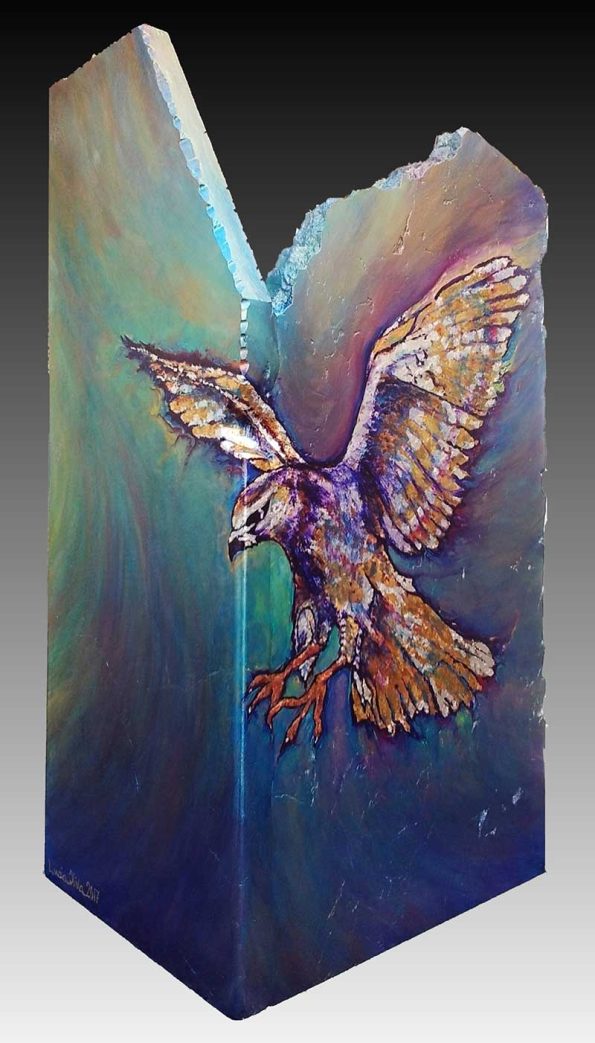
I always ask the artists what they really think about what is art. What is for you?
I might sound a bit naive, anachronistic or old-fashioned but to me art is Beauty with a capital B, as an absolute and eternal value. Through art I transmit my approach to life, which tends to see the positive side in each situation and be aware to thank for every happy moment, without never giving anything for granted. It is something that comes from my instinct but also from my past experiences: trying to get over difficult moments each one of us sooner or later faces, moving forward to see behind the obstacle a glimpse of beauty and thus of joy, something to give us the strength to keep on in spite of everything.
I do not want to speak about philosophy or moral, but more simply this is the message I instinctively want to share through figurative arts: a joyful hymn to the value of Beauty, which to me is expressed through the power of light, of colours, of movement and plastic shapes. This is based on my immense love for Nature as the maximum example of perfection, mighty and eternal power: the Universe, in which we are quick passing guests and that we need to respect and protect.
From this comes the search of a lifestyle as much as possible oriented to values of soberness, giving importance to precious and durable things. Consumerism is a danger for nature and ourselves, because it fulfills the soul and the life with false wishes, making us lose the way to the essential.

There are a great explosion of Contemporary artists in the last years. Are there so many buyers for all them?
This explosion of so many contemporary artists is wonderful. This means people discover more and more the value and the desire to express themselves through the nobility of art.
The question if there are enough buyers for all of them is very interesting and nice. I will try to answer in the same nice way. I think that the more the understanding for the value of art is spread, the more people will discover the pleasure and the joy to surround themselves with art, creating their own art collection, whether small or big, expensive or affordable. And its value is not evanescent like many consumer goods.
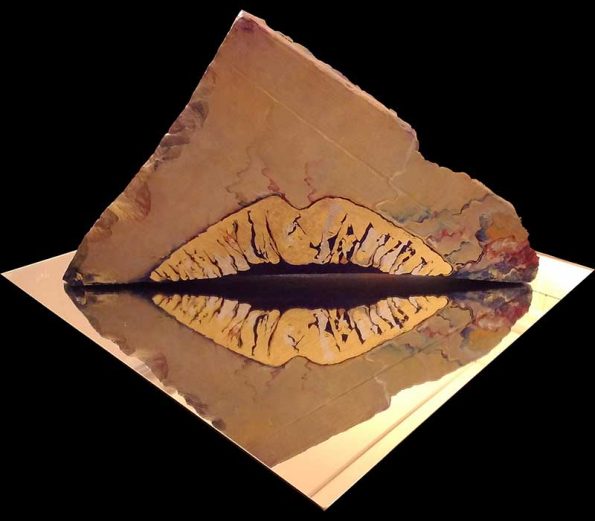
Why do you think collectors must invest in your artworks?
Oh, your questions are getting more and more intriguing and tricky. Joking apart, maybe the best way I have to answer is by using the words of art curators I met in my career and collectors of mine.
First of all because of its uniqueness and powerful innovative strength, which continuously surprises the viewer depending on the different perspective you choose to look at them.
Then also because the appreciation I receive is growing day by day and consequently, from a mere practical point of view, also the value of my artworks.
Last I humbly need to say that I feel very much honoured and rewarded by hearing that, according to all of them, my art tributes a homage to Beauty.
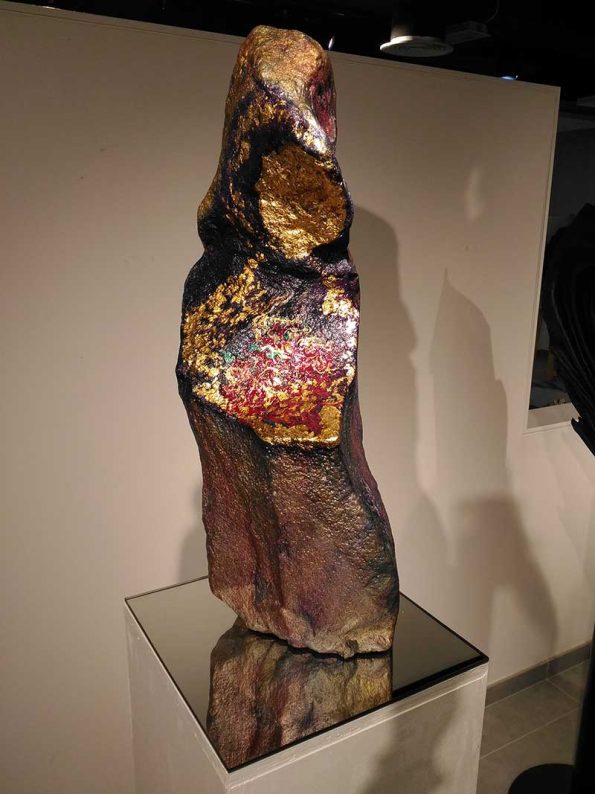
I know that you have good clients that like very much the way you do. What they have seen in your paintings?
Getting back to what I just said a few moments ago, the most positive appreciation I keep receiving is the pleasure of owning and putting in one’s collection something absolutely unique, that combines a highly innovative style with the gift of donating joy.

Italy, Oman… maybe other countries to have new experiences?
Obviously I like travelling and getting in touch with new people and cultures. As far as Oman’s nearby countries are concerned, I have exhibited and I’m appreciated in the Gulf (Dubai, Abu Dhabi, Bahrain,…). Among those we chose Oman to live in because of its authentic lifestyle, still respectful of tradition and for the astonishing beauty of nature.
In the area I have collectors in Egypt, Syria, Jordan, India, Iran… I am fascinated by new goals, exhibitions, meetings …so who knows.
And your future?
Definitely an art oriented life in all its forms and in close contact with Nature.

